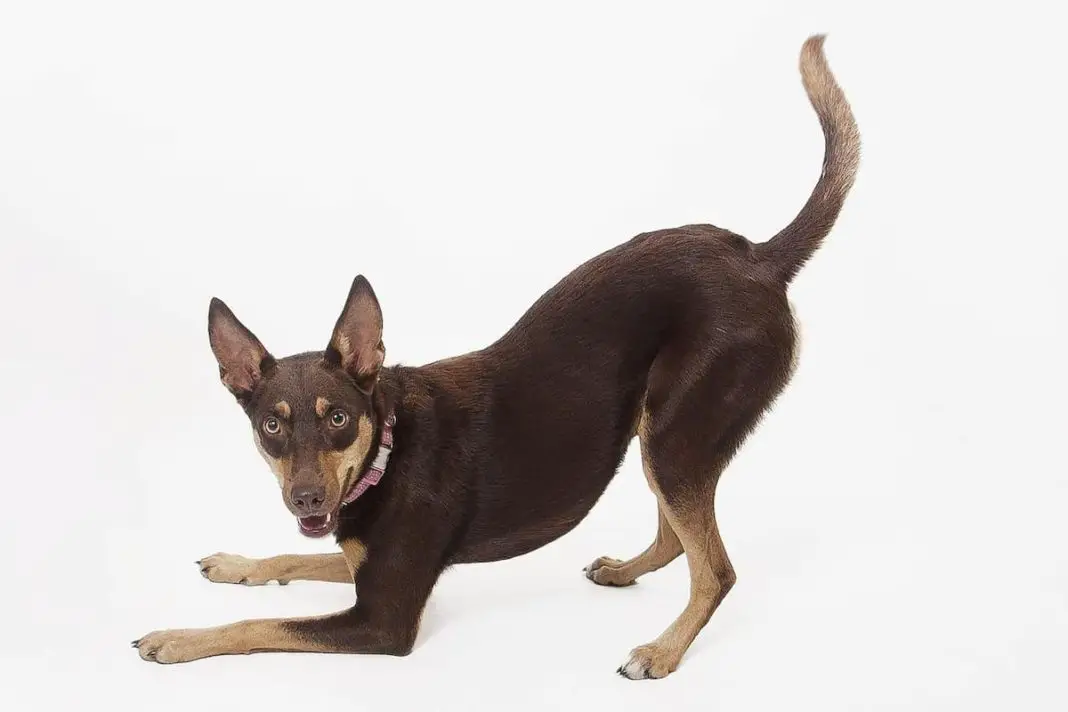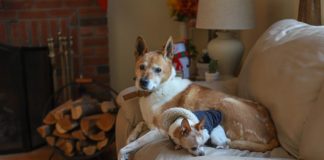How Much Exercise Does A Kelpie Puppy Need?
A young kelpie puppy has so much high energy that the idea of giving them extra physical activity in the form of exercise sessions may seem unnecessary. However, a Kelpie puppy needs lots of movement to develop their muscles and tire them out so they sleep well — they just need a lot less exercise than an adult Kelpie.
A Quick Description
The Australian kelpie is a medium-sized herding dog breed that hails from the land Down Under. Known for their athletic, muscular, and energetic body. Highly driven and intelligent, kelpies love nothing more than to work. In fact, Kelpies really need a job to do—hanging around the house for this dog breed isn’t an option.
Planning Regular Exercise For A Kelpie Puppy
A tired kelpie puppy is a well-behaved kelpie puppy. Depending on how your kelpie puppy plays, schedule several playtimes throughout the day for healthy exercise, which also helps to wear them out.
Kelpie puppies love to play. It also helps you to bond with your new kelpie puppy. You can use playtime to teach and practice basic obedience commands, like teaching “come.” Just doing five minutes a day will remind your Kelpie puppy of what you’ve already taught them, teach them new things, and wear out that mile-a-minute brain so it doesn’t go in search of trouble.
There’s one school of puppy performance that’s extremely conservative, which advocates some exercise but is less structured, letting the puppy spend its energy running around and perhaps playing with some of their puppy peers. The other school of thought says that as Kelpies are bundles of energy, especially puppies, owners should help them use up their energy in order to keep them somewhat civilized.
Start Using Baby Steps
Your Kelpie puppy is growing fast. Too much exercise and the wrong kinds of activity can actually damage a Kelpie puppy for life. Why? It’s something called “growth plates.” Located on the ends of your Kelpie’s leg bones and they consist of cartilage that gradually hardens into bone. Overly strenuous exercise, jarring activities like jumping or running down stairs, can damage the growth plates, which could actually leave a Kelpie puppy with deformities like bowed legs. So, until these plates close and are finished growing (which happens at around 18 months old), only moderate exercise is recommended.
It’s not recommended to encourage jumping or leaping games for young puppies. Definitely, no continuous leaping in the air for frisbees, although once in a while should be fine.
Exercise Tips
- You shouldn’t take your Kelpie puppy on lots of walks.
- Don’t try to turn your Kelpie puppy into a stair master. Some stair climbing throughout the day is fine, but not as an exercise program.
- You can play lots of fetch or whatever version of fetch your Kelpie can manage. Kelpies love chasing balls, so you shouldn’t have trouble engaging them.
- A young Kelpie shouldn’t be put on a leash for jogging or cycling. You need to give your Kelpie the opportunity to take natural breaks and rest. Hard surfaces such as concrete when your Kelpie is exercising.
- Playing games like hide and seek is more appropriate for a Kelpie puppy. They’ll love some running, sniffing, and mental concentration, to keep them stimulated. After a few minutes of this, don’t be surprised if you may see your Kelpie pup’s eyes closing and game time turns into nap time.
- The general rule for exercising Kelpie puppies is five minutes of exercise per month of age. So, a four-month-old Kelpie, a good twenty minutes at a time, is good.
- See if they enjoy the water. The earlier a Kelpie learns to swim, the more exercise time can be devoted to the water. As with humans, it’s a very body-friendly exercise for your puppy.
- As Kelpie puppies are very enthusiastic to constantly play in every game, every walk, every stick-throwing venture. Most pups don’t know when to stop and will run until they drop if you allow it, so always try to keep exercise in moderation.
- It’s not recommended to exercise a Kelpie puppy after eating. Although, they may still want to your puppy needs time to digest.
The 5 Best Exercises For Kelpie Puppies (Fun, Easy Routines!)
You need exercise for Kelpie puppies to keep them healthy, fit, and more importantly… out of mischief!
It’s common for Kelpie owners to mistakenly think that their young puppy needs “plenty” of structured exercise.
By the end of this article, you’ll have learned exercises for your Kelpie puppy that are easy, will boost growth and development and will be exciting and safe for both you and your Kelpie.
Rather than exercising on hard surfaces, exercise on soft surfaces, for example:
- Grass
- Sand
- Dirt paths or trails
Stretching of soft ligaments at too early an age strains a puppy’s growing joints, and carrying too much weight on their overall framework can and will harm a young puppy.
This leads to problems in adulthood which can be avoided!
How Much Exercise Is Too Much For A Kelpie Puppy?
A Kelpie puppy will let you know when they’ve had enough exercise by showing signs of tiredness.
How do I know when they’ve got enough exercise?
- Frequent resting
- Heavy panting and breath
- Lagging more than usual when on a walk
- Looking to stop on a walk
- Lying down on their belly or side
If your Kelpie is hyperactive and displays excessive chewing and destructive behavior, they may need engaging brain stimulation to help them use their brains to engage in their environments constructively.
Ideally, you should take time to teach them basic commands and house manners. Start with basic obedience training to avoid later behavior issues. Eventually, an active, adult Kelpie will need around 2 walks of 45 minutes each. But for now, but don’t overdo it.
The Best Exercise For Kelpie Puppies
The best exercise for a Kelpie puppy is off-leash walking and exploring. Until your vet clears your Kelpie as having their bones fully fused (this is around 12 to 18 months of age) activity should be cautious and slow-paced. Up to twelve months of age, natural free running is the best way to exercise Kelpie pups. With free running, your Kelpie is off-leash and can stop or slow when they want.
When your Kelpie is on a leash, they will keep with your speed (even if it’s too fast) as they constantly wish to please and keep up with you, to prevent this being the case limit and monitor on-leash walks and activity while your Kelpie is growing.
When walking on a leash, allow your Kelpie to:
- Walk at their own pace
- Stop and start as they please
- Sniff around leisurely to explore the trees, grass, and flowers
- Lay down, roll around, and dig in only approved digging places
Moderation and taking activity slow for the first 12 months of your Kelpie puppy’s life should be the rule. Avoid using any rough and tumble games, or activities that will cause your Kelpie puppy to twist their hips and body quickly.
There’re plenty of other ideas to try with a Kelpie puppy.
Below is a Kelpie puppy exercise chart and specific, step-by-step fun games to keep your new puppy happy and healthy.
| Puppy’s Age | Walking Time |
| 2 months old | Only 10 minutes of leisurely walking at a time |
| 3 months old | Only 15 minutes of leisurely walking at a time |
| 4 months old | Only 20 minutes of slow walking at a time |
| 5 months old | Only 25 minutes of slow walking at a time |
| 6 months old | Only 30 minutes of moderate walking at a time |
If you want to use a collar, then use a safe break-away collar that will release your Kelpie in the case of an emergency. Make sure to choose your collars and harnesses with care.
5 Fun Exercises Ideas For Kelpie Puppies
Exercise isn’t meant to wear your pup out. It’s meant to enhance the Kelpie’s natural growth and abilities. Don’t mistake exercising for a full-on aerobic activity or you’ll be doing your puppy a disservice.
Use activities to help your Kelpie pup learn about their movements in their environment and to stimulate their brains.
Here are some fun and easy ideas.
1. The Easy Pole Course
Place a few small plastic poles on the ground, i.e., a PVC poles or a broom handle.
Encourage your Kelpie to walk over a couple of the poles. They must practice this a few times before catching on to the way their bodies move when stepping over the pole obstacles.
As puppies are clumsy, don’t be surprised if your puppy stumbles a bit. So, it’s best to do this game in a soft area, like a carpeted room or fluffy grass.
Place the poles at different distances so the puppy needs to think about their paw placement and explore their body movement. The game can even be made more of a challenge by using more poles and moving them in different ways.
Benefits of the easy pole activity:
- Teaches balance
- Improves coordination
- Develops their spatial awareness
- Encourages them to learn their stride
- Can be done: 3 – 4 times a week
2. The Gentle Slope Walk
If you have access to gentle sloping grassy hill near where you live (the slope shouldn’t be steep or slippery).
The aim is to get your Kelpie puppy used to moving up and down inclines in a gentle, low-impact way. Only choose a slight slope that won’t cause your young pup to slip or scare them
Encourage your Kelpie to walk slowly and steadily up and down the slope. As they gain confidence in their abilities, their gait will gradually change to a more natural climbing motion. At the start, they may take small steps and hold their posture and head low to improve their balance and footing.
But, as the puppy grows in confidence, they’ll hold their heads higher, taking quicker steps. Go up and down the small slope no more than two to three times at each outing.
Benefits include:
- Coordination
- Balance
- Developing their musculoskeletal systems naturally
- Strength building
- Schedule: Twice a week
3. Playing Puppy Tug
The only way this game should be played is with you on the ground at the puppy’s level to avoid stressing their necks.
Don’t pull too hard or swing the tug toy. Keep in mind that your puppy’s teeth are tiny and could come loose if you pull too hard. Getting down to your puppy’s height also matches their strength. Don’t lift your puppy off the ground or swing them around with the toy!
If you stand or sit higher than the pup, it can strain their spine or neck as they grab and pull the toy.
It’s best to have a gentle game of tug to help them develop their strength, but don’t use excessive pulling. Remember that at the end, your puppy needs to give the toy back.
Doing this helps to maintain leadership in your relationship with your puppy.
Benefits include:
- Builds strength
- Improves balance
- Works on coordination
- Increases bonding with your young Kelpie
- Schedule: 3 – 4 times a week as a reward daily
4. Using low Impact Obstacles
Increase the number of objects your Kelpie will walk over. For example, you could use multiple PVC pipes.
You can do this by using the same steps that you did for the pole stepping activity, but make more obstacles to step over. You can get creative and have your Kelpie puppy follow you through your pipe setup.
Now, add in chairs that your Kelpie will crawl under.
Benefits include:
- Works and improves advanced coordination
- Increases muscle tone
- Schedule: 3 – 4 times a week
5. Finding Hidden Treasure
Buy a small plastic pool and fill it with crumpled newspapers.
Bury a treat or use your Kelpie’s favorite toy within the crumpled newspapers and then let your Kelpie puppy go hunting for some hidden treasures! When they find an item, give them praise.
Some plastic pools have slick bottoms, so use some old towels to place on the floor of the pool to avoid your puppy from slipping.
This is a great activity which helps mental skills, as they must think about finding the item and use their body, brain, and nose to find the object.
You can prevent your Kelpie from getting bored by using a variety of objects to find such as different treats or their favorite toys if you prefer to not use treats.
Benefits of this include:
- Increases mental stimulation
- Improves thinking processes
- Fun!
- Schedule: Twice a week
Should You Take A Kelpie Puppy To A Dog Park To Exercise?
It’s important to know that puppies aren’t fully vaccinated against common diseases found at dog parks until they have their first set of puppy vaccinations.
Dog parks can also be a troubling place for puppies as you don’t know the personality of the other dogs. Some dogs at your local dog park may have aggressive tendencies or play too rough.
As your puppy is still developing their social skills, it’s best not to risk an unpleasant incident at a dog park that may traumatize your pup.
Instead, try to find an approved puppy playgroup in your area or only go near vaccinated dogs good with energetic puppies.
Ideas For Pre-vaccination Activities
When you get your Kelpie puppy, they’re not yet fully vaccinated. A puppy could get sick exploring areas that are potentially dirty and frequented by unknown dogs.
For a puppy that’s not fully vaccinated, use these tips:
- You can use your yard or other people’s yards if you’re confident that it’s secure, escape-proof, and not open to stray dogs for outdoor time.
- Find clean areas that’re away from other dogs, like paths and trails.
- Indoor games on a soft, non-slip are a lot safer.
- Look to enrol in a local puppy socialization class where all the puppy’s vaccines are up to date.
- Find mental stimulation activities to help brain growth and development.
It’s recommended to stay safe and keep away from known areas frequented by dogs. Although, avoiding safe clean areas can hinder your Kelpie’s social and behavioral development.
Conclusion
Kelpie puppies love different activities that keep them moving and mentally healthy and you’ll need to choose what works for your Kelpie with care.
Use a gentle approach while your Kelpie puppy’s bones are still fusing to avoid any future problems. If you’re ever in doubt, check with your vet.
Exercise for Kelpie puppies should be done regularly to maximize their fitness, potential, and longevity.
You can always begin basic obedience commands for your Kelpie puppy without fear of impact or injury and work your way through the simplest commands first.
Remember to go easy in the first year. You’ll have plenty of time to run marathons with your Kelpie later!








